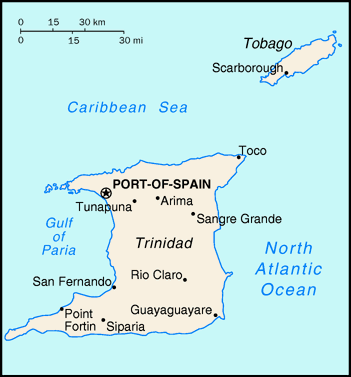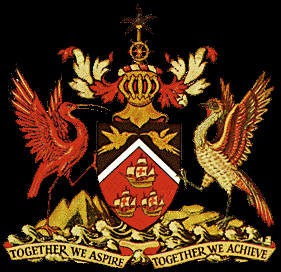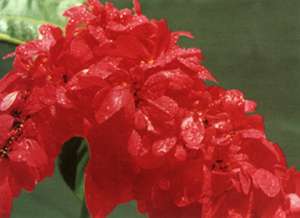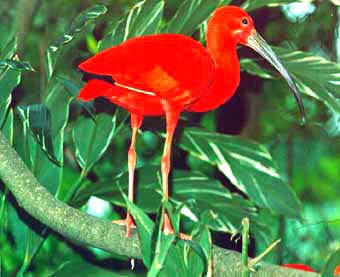
The island of Trinidad, the larger of the two, has an area of 4,828 square kilometres (1,864 square miles) and is situated at 10.5 degrees north of the equator. Trinidad has a mountain range running along the north coast of the island with the highest peak rising to 940 metres (3,085 feet) and rolling hills in the south of the island. Much of the north coast is densely forested and is home to a number of wild animals. Many of the island's more popular beaches are located on the north coast. There is a flat central plain where sugar cane is grown and much of the island's wet lands can be found.
Tobago is 300 square kilometres (116 squaremiles) in area and is situated just 32 kilometres (20 miles) off the north-east coast of Trinidad, 11 degrees north of the equator. Tobago has a central hilly range with a flat area in the south and west of the island where muchof the tourism has developed.

The capital of Trinidad and Tobago and the main centre of government is Port of Spain, which is situated in the north-west of the island of Trinidad. San Fernando, the second largest city in the country, also situated in Trinidad, is considered "the industrial capital" of the country. The principal administrative centre of Tobago is Scarborough. This is situated in the south of the island.

The islands are
warm all year round, with a mean air temperature ranging between
32 degrees Celsius (90 degrees Fahrenheit) at the maximum and 23 degrees
Celsius (73 degrees Fahrenheit) at the minimum. There are only two seasons,
a 'dry' that lasts from about January to May and a 'wet' that lasts
from June to December.
The annual rainfall is approximately 2,000 mm and the average number of
hours of daylight is approximately 11 hours per day.
Trinidad and Tobago is
a republic within the Commonwealth, with a president as Head of State.
An electoral college consisting of both Houses of Parliament elects the
President. Executive power lies with the prime minister and the Cabinet.
A bicameral Parliament whose normal term is five years exercises legislative
power. The date of elections can be advanced if the ruling party dissolves
Parliament or if it receives a vote of 'no confidence" in Parliament. The
36-member House of Representatives are elected by universal adult suffrage.
The Senate's 31 members are appointed by the president: 16 on the advice
of the prime minister; 6 on the opposition leader's; and 9 at his own discretion.
Tobago has a separate House of Assembly, consisting of 1 2 seats, which
controls some of the island's domestic affairs.
The judicial system is composed of the Supreme Court
and the District Courts. The Supreme Court of judicature
consists of the High Court of Justice and the Court of Appeals.
The Chief Justice and 10 Puisne judges represent the High Court.
The District Courts are composed of the Chief Magistrate, seven
senior and 18 Stipendiary Magistrates. In these courts, the work
of the Petty Civil Courts and Courts of Summary jurisdiction is conducted.
The Prime Minister, Basdeo Panday, of the United National Congress (UNC) political party.
.
The National Emblem: The
Coat of Arms
Our National Motto as
you can see is written on it at the bottom.
"Together we aspire, Together we achieve"

The Black represents the
dedication of the people joined together by one strong bond. It is the
colour of strength, of unity of purpose, and of the wealth of the land.
Red is the colour most expressive of the country; it represents the vitality
of the land and its peoples; it is the warmth and energy of the sun, the
courage and friendliness of the people. White is the sea by which these
lands are bound; the cradle of heritage; the purity of our aspirations
and the equality of men and women under the sun. The colours chosen represent
the
elements of the Earth,
Water and Fire which encompass all our past, present and future; and inspire
the people of Trinidad and Tobago as one united, vital, free and dedicated.

The honor of being chosen as our National flower goes to a wild, forest flower called the Chaconia also known as the "Pride of Trinidad and Tobago" and "Wild Poinsettia." The Chaconia is an indigenous flower known by its long sprays of magnificent vermillion. Coincidentally, this flower blooms on every anniversary of our Independence Day (August 31, 1962). For us, the Chaconia represents the imperishability of life and the continuity of our nation.
The Chaconia belongs to
the family Rubiaceae and owes its botanical name, Warszewiczia Coccinea
to the Polish-Lithuanian plant collector, Joseph Warszewicz. The title
"Chaconia" was given to it in honour of the last Spanish Governor of Trinidad,
Don Jose Maria Chacon (1784-1797).

The Scarlet Ibis of Trinidad

I solemnly pledge to dedicate
my life
To the service of my
God
And my Country.
I will honour my parents,
My teachers, my leaders
and my elders,
And those in authority.
I will be clean and honest
in all my thoughts,
My words, and my deeds,
I will strive, in everything
I do,
To work together with
my fellowmen,
Of every creed and race,
For the greater happiness
of all,
And the honour and glory
of my Country.
